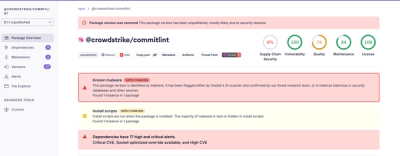
Research
Malicious fezbox npm Package Steals Browser Passwords from Cookies via Innovative QR Code Steganographic Technique
A malicious package uses a QR code as steganography in an innovative technique.
angular-oauth2-oidc
Advanced tools
The angular-oauth2-oidc package is an Angular library that provides support for OAuth 2 and OpenID Connect (OIDC) authentication. It allows developers to easily integrate secure authentication and authorization into their Angular applications.
OAuth2 and OIDC Authentication
This feature allows you to configure and initiate OAuth2 and OIDC authentication in your Angular application. The code sample demonstrates how to set up the OAuthService with the necessary configuration and initiate the login process.
import { OAuthService, AuthConfig } from 'angular-oauth2-oidc';
const authConfig: AuthConfig = {
issuer: 'https://your-identity-server',
redirectUri: window.location.origin + '/index.html',
clientId: 'your-client-id',
scope: 'openid profile email',
responseType: 'code'
};
oauthService.configure(authConfig);
oauthService.loadDiscoveryDocumentAndTryLogin();Token Management
This feature provides methods to manage tokens, including retrieving access and ID tokens, and refreshing tokens. The code sample shows how to get the access token, ID token, and refresh the token using the OAuthService.
import { OAuthService } from 'angular-oauth2-oidc';
// Get access token
const accessToken = oauthService.getAccessToken();
// Get ID token
const idToken = oauthService.getIdToken();
// Refresh token
oauthService.refreshToken();User Profile Information
This feature allows you to retrieve user profile information from the ID token. The code sample demonstrates how to get the identity claims and log them to the console.
import { OAuthService } from 'angular-oauth2-oidc';
// Get user profile information
const claims = oauthService.getIdentityClaims();
if (claims) {
console.log(claims);
}The oidc-client package is a JavaScript library for managing OpenID Connect (OIDC) and OAuth2 authentication. It is framework-agnostic and can be used with any JavaScript framework, including Angular. Compared to angular-oauth2-oidc, oidc-client provides more flexibility but requires more manual setup and integration.
The angular-auth-oidc-client package is another Angular library for implementing OAuth2 and OIDC authentication. It offers similar functionalities to angular-oauth2-oidc, such as token management and user profile retrieval. However, it has a different API and configuration approach, which some developers might find more intuitive or easier to use.
The auth0-angular package is an Angular SDK for integrating Auth0 authentication and authorization services. It provides a seamless way to implement OAuth2 and OIDC authentication with Auth0 as the identity provider. Compared to angular-oauth2-oidc, auth0-angular is specifically designed for use with Auth0 and offers additional features like user management and analytics.
Support for OAuth 2 and OpenId Connect (OIDC) in Angular.
Successfully tested with the Angular 2.x and it's Router, PathLocationStrategy and CommonJS-Bundling via webpack.
You can use the OIDC-Sample-Server mentioned in the samples for Testing. It assumes, that your Web-App runns on http://localhost:8080.
Username/Password: max/geheim
import { OAuthModule } from 'angular-oauth2-oidc';
[...]
@NgModule({
imports: [
[...]
HttpModule,
OAuthModule.forRoot()
],
declarations: [
AppComponent,
HomeComponent,
[...]
],
bootstrap: [
AppComponent
]
})
export class AppModule {
}
This section shows how to use the implicit flow, which is redirecting the user to the auth-server for the login.
To configure the library you just have to set some properties on startup. For this, the following sample uses the constructor of the AppComponent which is called before routing kicks in.
@Component({ ... })
export class AppComponent {
constructor(private oauthService: OAuthService) {
// URL of the SPA to redirect the user to after login
this.oauthService.redirectUri = window.location.origin + "/index.html";
// The SPA's id. The SPA is registerd with this id at the auth-server
this.oauthService.clientId = "spa-demo";
// set the scope for the permissions the client should request
// The first three are defined by OIDC. The 4th is a usecase-specific one
this.oauthService.scope = "openid profile email voucher";
// set to true, to receive also an id_token via OpenId Connect (OIDC) in addition to the
// OAuth2-based access_token
this.oauthService.oidc = true;
// Use setStorage to use sessionStorage or another implementation of the TS-type Storage
// instead of localStorage
this.oauthService.setStorage(sessionStorage);
// Discovery Document of your AuthServer as defined by OIDC
let url = 'https://steyer-identity-server.azurewebsites.net/identity/.well-known/openid-configuration';
// Load Discovery Document and then try to login the user
this.oauthService.loadDiscoveryDocument(url).then(() => {
// This method just tries to parse the token(s) within the url when
// the auth-server redirects the user back to the web-app
// It dosn't send the user the the login page
this.oauthService.tryLogin({});
});
}
}
When you don't have a discovery document, you have to configure more properties manually:
@Component({ ... })
export class AppComponent {
constructor(private oauthService: OAuthService) {
// Login-Url
this.oauthService.loginUrl = "https://steyer-identity-server.azurewebsites.net/identity/connect/authorize"; //Id-Provider?
// URL of the SPA to redirect the user to after login
this.oauthService.redirectUri = window.location.origin + "/index.html";
// The SPA's id. Register SPA with this id at the auth-server
this.oauthService.clientId = "spa-demo";
// The name of the auth-server that has to be mentioned within the token
this.oauthService.issuer = "https://steyer-identity-server.azurewebsites.net/identity";
// set the scope for the permissions the client should request
this.oauthService.scope = "openid profile email voucher";
// set to true, to receive also an id_token via OpenId Connect (OIDC) in addition to the
// OAuth2-based access_token
this.oauthService.oidc = true;
// Use setStorage to use sessionStorage or another implementation of the TS-type Storage
// instead of localStorage
this.oauthService.setStorage(sessionStorage);
// To also enable single-sign-out set the url for your auth-server's logout-endpoint here
this.oauthService.logoutUrl = "https://steyer-identity-server.azurewebsites.net/identity/connect/endsession?id_token={{id_token}}";
// Discovery Document of your AuthServer as defined by OIDC
// You don't need to set this, when the url aligns with the oidc standard
// (IssuerUrl + '/.well-known/openid-configuration')
// let url = 'https://steyer-identity-server.azurewebsites.net/identity/.well-known/openid-configuration';
// this.oauthService.loadDiscoveryDocument(url);
// Load Discovery Document and then try to login the user
this.oauthService.loadDiscoveryDocument().then(() => {
// This method just tries to parse the token(s) within the url when
// the auth-server redirects the user back to the web-app
// It dosn't send the user the the login page
this.oauthService.tryLogin({});
});
}
}
import { Component } from '@angular/core';
import { OAuthService } from 'angular2-oauth2/oauth-service';
@Component({
templateUrl: "app/home.html"
})
export class HomeComponent {
constructor(private oAuthService: OAuthService) {
}
public login() {
this.oAuthService.initImplicitFlow();
}
public logoff() {
this.oAuthService.logOut();
}
public get name() {
let claims = this.oAuthService.getIdentityClaims();
if (!claims) return null;
return claims.given_name;
}
}
<h1 *ngIf="!name">
Hallo
</h1>
<h1 *ngIf="name">
Hallo, {{name}}
</h1>
<button class="btn btn-default" (click)="login()">
Login
</button>
<button class="btn btn-default" (click)="logoff()">
Logout
</button>
<div>
Username/Passwort zum Testen: max/geheim
</div>
In cases where security relies on the id_token (e. g. in hybrid apps that use it to provide access to local resources)
you could use the callback validationHandler to define the logic to validate the token's signature.
The following sample uses the validation-endpoint of IdentityServer3 for this:
this.oauthService.tryLogin({
validationHandler: context => {
var search = new URLSearchParams();
search.set('token', context.idToken);
search.set('client_id', oauthService.clientId);
return http.get(validationUrl, { search }).toPromise();
}
});
Pass this Header to the used method of the Http-Service within an Instance of the class Headers:
var headers = new Headers({
"Authorization": "Bearer " + this.oauthService.getAccessToken()
});
There is a callback onTokenReceived, that is called after a successful login. In this case, the lib received the access_token as
well as the id_token, if it was requested. If there is an id_token, the lib validated it in view of it's claims
(aud, iss, nbf, exp, at_hash) and - if a validationHandler has been set up - with this validationHandler, e. g. to validate
the signature of the id_token.
this.oauthService.tryLogin({
onTokenReceived: context => {
//
// Output just for purpose of demonstration
// Don't try this at home ... ;-)
//
console.debug("logged in");
console.debug(context);
},
validationHandler: context => {
var search = new URLSearchParams();
search.set('token', context.idToken);
search.set('client_id', oauthService.clientId);
return http.get(validationUrl, { search}).toPromise();
}
});
This section shows how to use the password flow, which demands the user to directly enter his or her password into the client.
To configure the library you just have to set some properties on startup. For this, the following sample uses the constructor of the AppComponent which is called before routing kicks in.
Please not, that this configuation is quite similar to the one for the implcit flow.
@Component({ ... })
export class AppComponent {
constructor(private oauthService: OAuthService) {
// The SPA's id. Register SPA with this id at the auth-server
this.oauthService.clientId = "demo-resource-owner";
// set the scope for the permissions the client should request
// The auth-server used here only returns a refresh token (see below), when the scope offline_access is requested
this.oauthService.scope = "openid profile email voucher offline_access";
// Use setStorage to use sessionStorage or another implementation of the TS-type Storage
// instead of localStorage
this.oauthService.setStorage(sessionStorage);
// Set a dummy secret
// Please note that the auth-server used here demand the client to transmit a client secret, although
// the standard explicitly cites that the password flow can also be used without it. Using a client secret
// does not make sense for a SPA that runs in the browser. That's why the property is called dummyClientSecret
// Using such a dummy secreat is as safe as using no secret.
this.oauthService.dummyClientSecret = "geheim";
// Load Discovery Document and then try to login the user
let url = 'https://steyer-identity-server.azurewebsites.net/identity/.well-known/openid-configuration';
this.oauthService.loadDiscoveryDocument(url).then(() => {
// Do what ever you want here
});
}
}
In cases where you don't have an OIDC based discovery document you have to configure some more properties manually:
@Component({ ... })
export class AppComponent {
constructor(private oauthService: OAuthService) {
// Login-Url
//this.oauthService.loginUrl = "https://steyer-identity-server.azurewebsites.net/identity/connect/authorize"; //Id-Provider?
// Url with user info endpoint
// This endpont is described by OIDC and provides data about the loggin user
// This sample uses it, because we don't get an id_token when we use the password flow
// If you don't want this lib to fetch data about the user (e. g. id, name, email) you can skip this line
this.oauthService.userinfoEndpoint = "https://steyer-identity-server.azurewebsites.net/identity/connect/userinfo";
// The SPA's id. Register SPA with this id at the auth-server
this.oauthService.clientId = "demo-resource-owner";
// set the scope for the permissions the client should request
// The auth-server used here only returns a refresh token (see below), when the scope offline_access is requested
this.oauthService.scope = "openid profile email voucher offline_access";
// Use setStorage to use sessionStorage or another implementation of the TS-type Storage
// instead of localStorage
this.oauthService.setStorage(sessionStorage);
// Set a dummy secret
// Please note that the auth-server used here demand the client to transmit a client secret, although
// the standard explicitly cites that the password flow can also be used without it. Using a client secret
// does not make sense for a SPA that runs in the browser. That's why the property is called dummyClientSecret
// Using such a dummy secreat is as safe as using no secret.
this.oauthService.dummyClientSecret = "geheim";
// Load Discovery Document and then try to login the user
let url = 'https://steyer-identity-server.azurewebsites.net/identity/.well-known/openid-configuration';
this.oauthService.loadDiscoveryDocument(url).then(() => {
// Do what ever you want here
});
}
}
this.oauthService.fetchTokenUsingPasswordFlow('max', 'geheim').then((resp) => {
// Loading data about the user
return this.oauthService.loadUserProfile();
}).then(() => {
// Using the loaded user data
let claims = this.oAuthService.getIdentityClaims();
if (claims) console.debug('given_name', claims.given_name);
})
There is also a short form for fetching the token and loading the user profile:
this.oauthService.fetchTokenUsingPasswordFlowAndLoadUserProfile('max', 'geheim').then(() => {
let claims = this.oAuthService.getIdentityClaims();
if (claims) console.debug('given_name', claims.given_name);
});
Using the password flow you MIGHT get a refresh token (which isn't the case with the implicit flow by design!). You can use this token later to get a new access token, e. g. after it expired.
this.oauthService.refreshToken().then(() => {
console.debug('ok');
})
FAQs
Support for OAuth 2(.1) and OpenId Connect (OIDC) in Angular
The npm package angular-oauth2-oidc receives a total of 191,865 weekly downloads. As such, angular-oauth2-oidc popularity was classified as popular.
We found that angular-oauth2-oidc demonstrated a healthy version release cadence and project activity because the last version was released less than a year ago. It has 2 open source maintainers collaborating on the project.
Did you know?

Socket for GitHub automatically highlights issues in each pull request and monitors the health of all your open source dependencies. Discover the contents of your packages and block harmful activity before you install or update your dependencies.

Research
A malicious package uses a QR code as steganography in an innovative technique.

Research
/Security News
Socket identified 80 fake candidates targeting engineering roles, including suspected North Korean operators, exposing the new reality of hiring as a security function.

Application Security
/Research
/Security News
Socket detected multiple compromised CrowdStrike npm packages, continuing the "Shai-Hulud" supply chain attack that has now impacted nearly 500 packages.